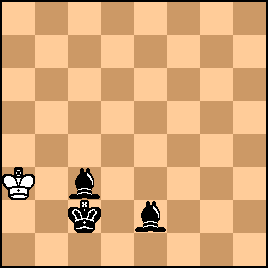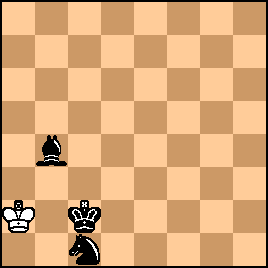fredthebear: Mating technique to finish with the Two Minor Pieces:
click for larger viewPreventing escape: The winning king takes care of the front door by using the opposition, and the two bishops take care of the back door. 103...Bb5 prevents escape out the back door.
104...Bb4 prevents escape out the back door.
105...Ba5 is an important WAITING MOVE to pass the turn. If instead 105...Bc4?? 1/2-1/2 Stalemate.
See Stalemate Diagram - White King to move cannot make a legal move: 
click for larger viewRealize that stalemate occurs when a non-check move is made. The purpose of the waiting move 105...Ba5 was to allow the lone king to return to a checkable square (the opposition). The successful checkmate pattern with the Two Minor Pieces: It is necessary to check the lone king on the square next to the corner (in this case the a2-square). Then checkmate the lone king in the corner. Thus, the last two moves are always check by one minor piece, then check by the other minor piece. This same principle applies to K-B-N vs K checkmates as well. The knight would give check on the square next to the corner, and the bishop gives the final check in the corner. See diagram: 
click for larger viewThe bishop prevents the backdoor escape. The kings are in opposition. The knight gives the next-to-last check next to the corner, and the bishop gives the final check to the cornered king. A waiting move may be necessary to pass the turn and properly time the next-to-last check next to the corner. This same technique applies to mating in the corner with two bishops. My students understand the plan to cut-off the lone king from escaping the edge. Then give check-check the last two moves, one by each minor piece. Sorry for the long-winded explanation. I don't teach two minor piece mates to beginning players to avoid frustrating them. We practice elementary mates with the queen(s) or rook(s) often so they KNOW HOW TO WIN. We also review stalemate positions and perpetual check positions and insufficient mating material positions so they are very familiar with all the ways a game of chess can end. We don't want a tricky or ignorant opponent telling them they have lost when the position is truly drawn. When does the fallen flag not apply as a loss? Students need to know. | 




